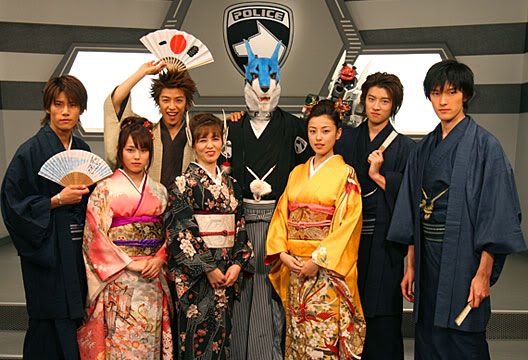
The people and the doggy dummy are the characters of TOKUSOU SENTAI DEKARANGER (特捜戦隊デカレンジャー) from the above image. Aren't they cute?
Anyway, I'm going to talk first about the tremendous KIMONO.
Kimono (着物/기모노), is the national costume of Japan. riginally the word "kimono" literally meant thing to wear (ki "wearing" and mono "thing") but now has come to denote a particular type of traditional full-length garment.
Kimono are T-shaped, straight-lined robes that fall to the ankle, with collars and wide, full-length sleeves. Kimono are wrapped around the body, always with the left side over the right (except when dressing the dead for burial) and secured by a wide belt called an "obi", which is usually tied at the back. Kimono are generally worn with traditional footwear (especially "zouri" or "geta") and split-toe socks (tabi).
Today, kimono are most often worn by women, and on special occasions. Traditionally, unmarried women wore a style of kimono called "furisode", which have floor-length sleeves, on special occasions. A few older women and even fewer men still wear kimono on a daily basis. Men wear kimono most often at weddings, tea ceremonies, and other very special or very formal occasions. Professional sumo wrestlers are often seen in kimono because they are required to wear traditional Japanese dress whenever appearing in public. They commonly wear the kind of casual Japanese attire that is referred to as "yukata", which is of plain unlined cotton.
Kimono hobbyists in Japan can take courses on how to put on and wear kimono. Classes cover selecting seasonally and event-appropriate patterns and fabrics, matching the kimono undergarments and accessories to the kimono, layering the undergarments according to subtle meanings, selecting and tying obi, and other topics. There are also clubs devoted to kimono culture, such as "Kimono de Ginza".

The characters are from GOONG (궁/宫), or more known as PRINCESS HOURS in the Philippines.
Now, I'm gonna talk about the alluring HANBOK.
Hanbok (한복/韓服) or Joseon-ot (조선옷/朝鮮옷) is the traditional dress of North Korea and South Korea. t is often characterized by vibrant colors and simple lines without pockets. Although the term literally means "Korean clothing", hanbok today often refers specifically to Joseon Dynasty-style semi-formal or formal wear that is worn during traditional festivals or celebrations.
I don't have so much things to explain about Kimono and Hanbok.
Since I adore Japan and Korea.







No comments:
Post a Comment